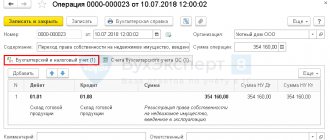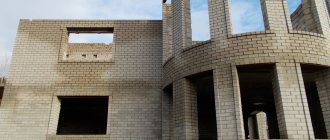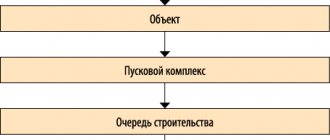The unified form KS-6a is one of the main documents that is created to monitor the construction process, both from the management of the contracting organization, and from the customer and regulatory authorities. In other words, KS-6a is a special cumulative journal, a primary accounting document, which is drawn up after any type of construction and installation work is completed on any particular section of a construction site. It consistently reflects the stages, conditions and timing of certain construction works.
What is the KS-6 form (general work log)
Form No. KS-6 was approved by Decree of the State Statistics Committee of Russia dated October 30, 1997 No. 71a. It corresponds to number 0336001 according to OKUD. It is used to record the performance of various works related to construction and installation, and is one of the primary documents that record the technological sequence, quality level, conditions for the production of relevant types of work, as well as their timing.
The form in question is used when carrying out work within the same construction site, involving the construction, reconstruction or expansion of objects that can be combined into a group of the same type or considered as independent.
The general work log in the KS-6 form is kept by an authorized employee of the developer, customer or performer of work at the site, for example, a senior work producer or shift manager who is responsible for carrying out production work at the site.
The following can take part in the procedure for filling out the KS-6 form:
- developer representatives;
- customer representatives;
- employees of the organization developing design solutions.
Along with the KS-6 form, the Russian construction industry uses a document approved in Appendix No. 1 to Rostechnadzor Order No. 7 dated January 12, 2007 (this regulatory legal act was also assigned another number - RD-11-05-2007).
Many legal entities and individual entrepreneurs working in the construction industry fill out both forms for reporting purposes, since in practice government agencies carrying out construction supervision can request either of them - there are no clear criteria for choosing a specific form of the general work log in the legislation.
Read about the features of cost accounting during construction work in the material “Procedure for accounting costs in construction (nuances).”
Construction control is a mandatory stage, the absence of which can lead to fines. ConsultantPlus experts explained in detail how to properly carry out construction control and reflect it in the general work log. Full trial access to the K+ system can be obtained for free.
Form RD-11-05-2007 as an alternative to the KS-6 journal
Order No. 7 of Rostechnadzor dated January 12, 2007 establishes, first of all, the procedure in accordance with which the general work log should be kept. This order was issued in order to implement the provisions of Art. 54 of the Town Planning Code of the Russian Federation, as well as sub. “b” clause 13 of the Regulations on state construction supervision, approved by Decree of the Government of the Russian Federation dated 01.02.2006 No. 54.
The general work log, in accordance with the provisions of the order RD-11-05-2007, is a source in which:
- records are kept of all work related to construction, reconstruction, and major repairs;
- the sequence of performance of the relevant work is reflected;
- the terms and conditions of work are indicated;
- information on control and supervision carried out by government agencies is recorded.
The general work log in the form RD-11-05-2007 must be submitted no later than 7 days before the actual start of work to the state body carrying out the construction supervision procedure in cases provided for by the provisions of paragraph 1 of Art. 54 of the Town Planning Code of the Russian Federation. Along with the journal, this body is provided with:
- a copy of the construction permit;
- design solutions;
- a copy of the document confirming the placement of so-called red lines on the area;
- work logs classified as special;
- conclusion of an examination of design solutions, if one is required, based on the provisions of Art. 49 of the Code.
The state body carrying out construction supervision seals this journal, as well as special journals, puts a registration signature on them and returns the corresponding package of documents to the developer or customer so that they can keep records of the work. If the current journal ends, then a new copy must be registered with the construction supervision authority, on which a mark with the number - 1, 2, etc. must be affixed.
Completed logs in form RD-11-05-2007 must be kept by the developer or customer until the completion of the final inspection carried out by the construction supervision authority. During the period of such inspection, the journal is at the disposal of the relevant regulatory authority.
Section three
This section is the main one - it includes detailed information about all work performed in all areas of the construction site with a mandatory indication of the period of their implementation. The more carefully all information is recorded, the better. Sometimes they even indicate the number of the floor and room in which construction work is being carried out, the quantity and brand of material used, etc. Information must be entered into this section daily until the object is handed over to the customer. If suddenly a failure occurs during the work, its reasons must be entered here, and each entry made must be signed by the site manager or foreman monitoring the progress of work.
What is a journal of work performed in form KS-6a?
Form KS-6a was approved by Decree of the State Statistics Committee of the Russian Federation dated November 11, 1999 No. 100. It corresponds to number 0322006 according to OKUD.
The logbook for the work performed in the KS-6a form must be kept by the work performer, using:
- data on measurements of completed work at construction sites;
- information on uniform standards and prices relating to structural elements or types of work.
Based on the information contained in this journal, the following are compiled:
- acceptance certificate - in form KS-2;
- certificate of cost of work - in form KS-3.
You can learn more about forms No. KS-2 and KS-3 and see examples of filling them out in the articles:
- ;
- “Unified form No. KS-3 - form and sample”.
Can an organization be fined under Art. 120 of the Tax Code of the Russian Federation in case of failure to keep a log of work performed in form KS-6a, if it uses form KS-2? The answer to this question is in ConsultantPlus. If you do not have access to the K+ system, get a trial online access for free.
But why is the KS-6a form needed if information about work on construction sites is recorded in the KS-6 or RD-11-05-2007 journal?
The main difference between this journal form and the previous ones is that information on work is always entered into it for each property separately. While forms KS-6 and RD-11-05-2007 allow the inclusion of information on the construction site as a whole.
Main purpose
Control of construction and installation work is carried out both by stages, and by individual types, and by the facility as a whole. For example, upon completion, an acceptance certificate is signed in form KS-11. In the case of the KS-6a form, the purpose of the document comes down to 3 tasks:
- Accounting for all work actually completed at this stage (reporting function).
- Accounting for the development of the estimate - subsequently, on the basis of financial data, a certificate of cost is drawn up (its form is designated KS-3).
- Finally, the document can be used as primary or additional evidence during possible trial or pre-trial proceedings (in case of disagreement).
The journal must be kept by the contractor with whom the customer has entered into a corresponding agreement. The data to be filled out is taken on the basis of measurements taken, their correlation with accepted standards and prices that are relevant at a given time. Measurements and assessments are made:
- for a specific type of work (for example, installation of structures, finishing, roofing, excavation, etc.);
- for each structural element (foundations, walls, ceilings, etc.).
The journal is filled out for each calendar year. When a new year begins, a new document must be created.
Are journals KS-6, KS-6a and RD-11-05-2007 required to record work performed?
Information from the Ministry of Finance of the Russian Federation dated December 4, 2012 No. PZ-10/2012 contains the department’s opinion with reference to the new law dated December 6, 2011 No. 402-FZ that it is not necessary to use unified forms of primary documentation from 2013.
These forms, on the one hand, include forms KS-6 and KS-6a. On the other hand, there are no criteria that allow us to classify the RD-11-05-2007 form as unified. What document, then, should Russian builders use to record work?
In this case, it is legitimate to talk about the need for a correct comparison of legal norms and law enforcement practice.
As for the first aspect, the provisions of sub. “b” clause 13 of the Decree of the Government of the Russian Federation dated 01.02.2006 No. 54 instructs construction supervision authorities to somehow check the availability of a general work log. On the one hand, the legislator does not specify its form, on the other hand, in the same subsection. “b” clause 13 of Resolution No. 54 introduces a rule according to which the procedure for maintaining the relevant journal is established by Rostechnadzor. Since this department issued document RD-11-05-2007, we can conclude that the form of the construction work log should, first of all, correspond to that approved in RD-11-05-2007.
However, as practice shows, in many regions of the Russian Federation, construction supervision authorities, due to the established legal tradition, require keeping a log in the KS-6 form. Sometimes both forms are requested at once.
Moreover, among lawyers there is a widespread point of view according to which form No. KS-6a is primary in relation to other journals, even in cases where the real estate object is the only one on the site. Since it is not necessary to use unified forms, the construction supervision authority may well request it (or a similar one).
Thus, in practice, it may be necessary to provide the construction supervision authority with all 3 documents we considered:
- form KS-6;
- form KS-6a;
- form RD-11-05-2007.
It all depends on the policies of regional government structures that supervise the construction sector. But very often the state limits itself to requesting a document approved in accordance with RD-11-05-2007 - perhaps due to the fact that the need to fill it out becomes obvious upon a literal reading of the provisions of Government Resolution No. 54 dated 01.02.2006.
For information on how labor protection is carried out during construction work, read the material “Rules for labor protection in construction.”
Not every uniform form is required
The question is, aren’t the unified forms approved by the State Statistics Committee of Russia generally binding?
Column No. 4 indicates units of measurement by type of work. For example, if this is laying a road with bitumen, then in this case you can indicate square meters. The question is important, let's figure it out. How a departmental act becomes normative Contrary to widespread belief, not all of the unified forms are mandatory for use. The fact is that decisions of the State Statistics Committee of Russia of an interdepartmental nature, which were not submitted for state registration to the Ministry of Justice of the Russian Federation (Ministry of Justice), are not considered normative legal acts. The requirements of such acts are not equivalent to mandatory state regulations intended for repeated use.
So, the Ministry of Justice did not consider all the decisions that introduced unified forms. Indeed, during the period of approval of resolutions containing unified forms, the State Statistics Committee of Russia was a federal executive body.
Publication rules
Sample of filling out the general work log according to form KS-6
On the title page of the KS-6 journal we record:
- name of the organization carrying out construction work, its address, OKPO;
- description of the object (for example, “monolithic residential building with underground parking”), its address;
- Full name, position of the representative of the legal entity responsible for the construction of the building, as well as for maintaining the journal;
- name of the design organization, full name, position of its representative;
- name of the customer, if it is a legal entity - position, full name of the representative;
- the start and end dates of work - according to the contract or actually (if they coincide, then we write only the terms under the contract);
- number of pages in the magazine (it must be bound and numbered);
- Full name, position of the head of the company that issued the magazine;
- key characteristics of the building, cost of work in words and figures (for example, “20-story residential building with a parking lot for 100 parking spaces. The cost of work is 30,000,000 (thirty million) rubles. 00 kopecks.”);
- name of the approving authority and date of approval of the construction project (for example, “Department of the Smolensk Region for Architecture and Construction”, 02/17/2017);
- name of subcontractor organizations - if any are involved in the implementation of the project;
- The name of the organization that developed the project documentation must match that indicated above.
Filling out sections of the KS-6 form
A sample of filling out the KS-6 form can be downloaded from our website:
Section 1 states:
- Full name, positions of the company employees performing the work, as well as the areas in which they work (for example, “Andreev S.V., foreman, installation of building structures”);
- start and end dates of work performed by a specific employee;
- information about the document confirming the employee’s qualifications (for example, “Engineer Qualification Certificate No. 111 222, issued on 12/10/20XX”).
To learn about the professional requirements for construction workers, read the article “Professional Standards in Construction.”
Section 2 reflects:
- names of various acts related to construction (for example, “Act on the assembly of building structures”, “Act on approval of the technical report and drawings”);
- dates of signing of the relevant acts, full names and positions of the employees who signed them.
For each act, a serial number is recorded.
Section 3 states:
- dates of activities for monitoring and assessing the quality of work;
- names of structural parts of buildings, indication of their location, links to the numbers of the corresponding drawings (for example, “Pit, drawing No. 20 dated 08/20/20XX”);
- control results (for example, “The pit corresponds to the drawing, there are no complaints”);
- names of the companies that carried out the inspection, full names and positions of the inspection specialists.
In section 4 it is necessary to record:
- names and dates of issue of special journals used during the implementation of the construction project (for example, “Journal for conducting engineering tests, 04/15/2017”);
- names of companies maintaining relevant journals, full names and positions of employees responsible for maintaining these documents;
- dates of delivery and acceptance of special journals, signatures of the general director of the contractor organization.
Section 5 provides:
- start and completion dates of work - in one column (for example, “05/01/2017–05/17/20ХХ”);
- description of the work, conditions for its implementation, full name and position of the responsible persons (for example, “Installation of construction equipment, responsible: foreman Andreev S.V.”);
- position and signatures of the employee responsible for working with the magazine.
For information on the document used to formalize the acceptance of completed construction work, read the material “Acceptance Certificate of Completed Construction Work - Sample.”
Section 6 is completed by employees of government agencies. They record:
- date of inspection;
- comments, full names, positions of inspectors;
- notes indicating that the comments were accepted for implementation, and checking that the reasons that caused them have been eliminated.
On the last page of form No. KS-6 after section 6 the following is indicated:
- number of sheets in the document;
- Full name, position, signature of the person in charge, seal;
- date of signing of the journal.
Form RD-11-05-2007 as an example of filling out a general work log
You can download a completed sample of the specified form RD-11-05-2007 on our website:
The main differences in filling out the title page of the form in question and the previous one in terms of filling out the title page:
- in the form RD-11-05-2007 it is assumed to indicate the name of the developer, the customer and the organization that actually carries out the construction;
- in the form RD-11-05-2007 it is expected to indicate the persons responsible for construction control - from the customer or developer or from the company that carries out the construction;
- in the form RD-11-05-2007, the state supervisory authority puts marks on the title page.
The main differences between the form RD-11-05-2007 and KS-6 in terms of filling out section 1:
- the name of the company carrying out the construction is indicated;
- Full name is indicated. and the position of a representative of the construction company;
- information about the document confirming the employee’s qualifications is not indicated.
Regarding section 2 of the general work log:
- this section of the RD-11-05-2007 form coincides in purpose with section 4 in the KS-6 form;
- The information indicated in the section is certified by the signature of a representative of the developer or the customer.
Regarding Section 3
- this section coincides in purpose with section 5 in the KS-6 form;
- the position and full name are indicated. representative of the company that carries out the construction.
As for sections 4 and 5, section 3 in form KS-6 corresponds to those in purpose, however, the structure of sections in form RD-11-05-2007 differs significantly from that in form No. KS-6. Thus, in sections 4 and 5 of the form under consideration the following is recorded:
- serial number of the control activity;
- control data;
- information about identified deficiencies, the deadline and date for their elimination;
- Full name, position of representative of the developer or customer.
Besides:
- the information in section 4 is certified by the signature of a representative of the developer or customer;
- the information in section 5 is certified by the signature of a representative of the company carrying out the construction.
Section 6 of the general work log in form RD-11-05-2007 generally corresponds in structure and purpose to section 2 in form KS-6.
Section 7 corresponds in purpose to section 6 in the KS-6 form. Main differences:
- the form RD-11-05-2007 records the period and date for eliminating the violations identified during the supervisory inspection;
- The number of the event is recorded in order.
Filling out the table
The second part of the magazine concerns basic information on the construction project. So, let's start in order.
- Column 1. This indicates the serial number in this document of one or another type of work performed at the construction site;
- Column 2. The work position according to the estimate is entered here;
- Column 3. Reflects the name of the type of work (it must be written in sufficient detail and clearly so that different interpretations cannot arise);
- Column 4. You can put a dash here (if the contract already clearly states the cost of construction work);
- Column 5. The unit of measurement for the type of work is entered here. For example, if this is paving a plot of land, then you can indicate square meters, etc.;
- Column 6. This includes the cost of performing a unit of work, for example, how much the same asphalting of one square meter will cost;
- Column 7. Number of works - how many sq.m. paved.
- Column 8 contains the estimated cost of the work. This value is calculated by multiplying the indicators from the two previous columns (No. 6.7);
- Columns 9-44 contain the quantity and cost of work performed monthly, as well as the number of works performed since the beginning of construction at the time of a particular month (this figure is a cumulative total, which is the result of summation from the beginning of the year).
- Column 45. The total number of works for each type for the entire time is recorded here;
- Column 46. This includes the total cost of work for all months of the year;
It should be noted that all months are divided into three columns, and the necessary information must be entered into each of them.
It should be noted that all values from columns containing monetary values must be calculated and recorded in the final line “Total”, and if in any month according to the estimate there were no expenses or invoices, then the numbers in the “Total” column must be copied to column "Total". If there were overhead and other costs, they need to be added to the numbers in “Total” and this final total must be entered in the “Total” column.
The accounting journal in form KS-6a must be laced with a thick thread, numbered and sealed with the signature of the person responsible for filling it out and the seal of the company that issued it.
After the construction and installation work is completed, the general log must be handed over to the customer for storage. The second option is to give this document for storage to the operating company, which is subsequently responsible for the finished structure.
Example of filling out form KS-6a
The completed form KS-6a is available for download on our website:
The following is recorded on the title page of the document:
- names, addresses, OKPO, telephone numbers of the customer and contractor;
- construction site address;
- description of the construction project and a summary of the work (for example, “Development of a foundation pit for a 20-story residential building with an underground parking lot”);
- estimated or contractual cost of the project - in numbers;
- Full name, position of the journal compiler, his signature;
- Full name, position of the contractor's manager, his signature.
The main section of the KS-6a form is presented in the form of a table with 46 columns.
Another sample was prepared by ConsultantPlus experts. Study the material by getting trial access to the K+ system for free.
Column No. 1 records the serial number of the record about a particular work performed at the site. Column No. 2 indicates the position of this work according to the estimate. Column No. 3 reflects the name of the corresponding work.
A dash is placed in column No. 4 if the cost of construction work is fixed in the contract (letter of the Ministry of Finance of the Russian Federation dated May 31, 2005 No. 01-02-9/381).
Column No. 5 indicates the unit of measurement that correlates with the nature of the work. For example, if this is the development of a pit, then the volume of soil extracted from the ground in cubic meters may be indicated.
Column No. 6 records the cost of performing a unit of work - in our case, this is the cost of extracting 1 cubic meter. meter of soil in rubles.
Column No. 7 indicates the amount of work - in our case, cubic meters. meter of soil extracted from the ground.
Column No. 8 indicates the estimated cost of the work - as the product of the indicators recorded in the previous 2 columns.
Columns No. 9, 10, 11 indicate, respectively, the number of works, their cost for January, as well as the total since the start of construction. Columns No. 12, 13, 14 contain the same indicators for February. Moreover, if in January any indicators were recorded in column No. 11, they are summed up with the figures in column No. 13 and entered in column No. 14. If not, the indicators in columns No. 10, 13 are summed up, after which the resulting result is entered in column No. 14. Similarly, the columns for March and subsequent months are filled in with a cumulative total.
Column No. 45 records the total number of works in a particular type, and column No. 46 records their total cost for all months of the year.
In all columns in which indicators are recorded in rubles, for example, in columns No. 8, 10, 11, 13, 14, the total indicator is calculated and entered in the “Total” column. If in the reporting month there were no overheads or other expenses not included in the estimate, then the figures in the “Total” column are copied to the “Total” column. If there were overheads and other costs, they must be added to the corresponding figures in “Total” and the result recorded in the “Total” column.
How to fill it out correctly
Filling is cumulative in nature - as the next stage of construction work is completed (or the final installation of a separate structural element), a new cost is filled in. The number of pages will vary, but all information in it is filled out in tabular form.
Front page
The document should reflect the following information:
- Information about all aspects of the work (about the customer and the contractor):
- names (can be abbreviated, for example, Stroybeton LLC);
- legal addresses;
- Contact phone numbers.
- The name of the construction site and its address, for example, “A 10-story residential building with an underground parking lot for 100 cars and a heating point.”
- Object - this means a specific type of construction and installation work (for example, carrying out general construction earthworks for the “name of the construction site”).
- Codes for OKUD, OKPO and OKDP.
- Information on a previously signed contract: date of signing and number.
- The name of the document, an indication of the year for which it is maintained.
- Cost of construction work under the contract (in words, in rubles, without kopecks).
- A note about who filled out the form (for example, a capital construction engineer): signature, position, signature transcript.
- A note about who checked the filling (usually the general director) - similar to the position, signature and transcript of the signature (last name, initials).
Main part: even pages
The main part of the form is presented in the form of a table. Moreover, on the even-numbered pages there is a table indicating all the work performed by month. The following data is provided:
- Numbering is carried out in order (chronologically), as well as in accordance with the numbering according to the estimate - i.e. 2 systems are used at once.
- This is followed by the name of the type of construction and installation work (in accordance with the accepted classification) or the name of the structural element on the creation of which the work has been completed.
- The price number, unit of measurement, and price for this unit (in rubles) are given.
- The amount of work is prescribed in accordance with the estimate (the amount is indicated).
- The estimated cost is written down.
- This is followed by a report for each month (for work actually completed). The following information is provided:
- quantity and cost;
- cost on an accrual basis (cumulative order) – i.e. since the beginning of the year in total.
Body: odd pages
For odd-numbered pages, information continues to be recorded only by month:
- quantity and cost;
- cumulative total cost.
Sample and form 2019
This year, there have been no changes in terms of the form of the journal and the requirements for filling it out. A ready-made example of a completed KS-6a form, which you can rely on as a sample, is given below.
- Here's a blank form:
- All empty fields are neatly crossed out with a simple straight line of the same color that was used to fill out the main part of the magazine.
NOTE. Corrections, blots, unreadable inscriptions, strikethroughs and the inscription “Believe what is corrected” are not allowed in the journal. The form must be filled out with the utmost care; if necessary, individual sheets with erroneous information are replaced with new ones with correct data.
How to create a form in the program: video instructions
The journal can be filled out not only manually, but also using a special program - for example, it is convenient to create a document in SmetaWIZARD. You can see how to do this here.
Is it necessary to keep a journal?
Among engineers, the question of how obligatory it is to keep a journal is often discussed, and whether it is possible to get by with a different model, adapting the form to suit your specific tasks.
The answer in this case is unequivocal: maintaining the document is mandatory, since it is the main source of information for recording all construction work performed - both by type and by individual structural elements.
In addition, it is on the basis of this data that the associated reporting documents - KS-2 and KS-3 - are formed. Therefore, correct, timely and complete registration of the journal is mandatory for each responsible person (usually one of the engineers is appointed).
NOTE. The absence of form KS-6a may be considered by tax inspectors as a violation of the law. In this case, there is no reason to believe that KS-2 and KS-3 were drawn up correctly, since there is no source of information on the basis of which these documents were drawn up.
Results
The general work log is presented in several forms: form KS-6, KS-6a and RD-11-05-2007.
The form in question is used when carrying out work within the same construction site, involving the construction, reconstruction or expansion of objects that can be combined into a group of the same type or considered as independent. You can find more complete information on the topic in ConsultantPlus. Free trial access to the system for 2 days.





